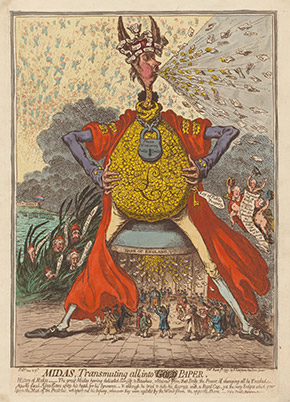WASHINGTON, DC.- Prints and drawings have consistently served as popular media for humor in art. Prints, which can be widely replicated and distributed, are ideal for institutional mockery and social criticism, while drawings, unmediated and private, allow for free rein of the imagination. Sense of Humor will celebrate the rich yet often overlooked tradition of humor in works on paper, ranging from the 15th to 20th century. On view in the West Building of the
National Gallery of Art, Washington, from July 15, 2018, through January 6, 2019, the exhibition is organized broadly chronologically, tracing the variety of forms that comical prints and drawings have taken over time, from Renaissance caricature to British satire in the 18th century and counterculture comics of the late 1960s. Drawn entirely from the Gallery’s collection, works are by artists including Pieter Bruegel the Elder, Jacques Callot, William Hogarth, Francisco de Goya, Honoré Daumier, George Herriman, Alexander Calder, Roger Brown, the Guerrilla Girls, and Art Spiegelman. Many works will be shown for the first time.
"Humor is a fundamental element of the human experience, and has too often been overlooked in the history of art," said Earl A. Powell III, director, National Gallery of Art, Washington. "This exhibition takes a closer look at the many ways comedic works of art—specifically works on paper—have been used to elicit a laugh, make a critique, or reveal a truth. This exhibition would truly not have been possible without the extraordinary depth and breadth of our collection of prints and drawings."
The first section of Sense of Humor focuses on the emergence of humorous images in prints and drawings from the 15th to 17th centuries. Satires and caricatures gained popularity during this era, poking fun at the human condition using archetypal figures from mythology and folklore. While not yet intended as caricatures of individuals, Italian works reflected the Renaissance interest in the human figure and emotion. Leonardo da Vinci explored facial features and expressions in drawings like Two Grotesque Heads (1510s). Created by his pupil, Francesco Melzi, the pen-and-ink drawing of an elderly woman and man in profile appears to be more a generic type than a study of an actual figure, but shows the exaggerated features that would come to define caricature. Typical examples from northern Europe include Daniel Hopfer's Bolikana and Markolfus (early 16th century), which derives from the popular story of a clever peasant outwitting a person of higher status and education.
Several later works by Jacques Callot, the brilliant 17th-century French observer of courtly life and costume, include a vibrant pen-and-ink drawing. Satirical images referring to specific people, events, or behaviors became common toward the end of this period. These are seen in early political cartoons such as the German Allegory of the Meeting of Pope Paul II and Emperor Frederick III (c. 1470), showing the pope and emperor engaged in a wrestling match. A later Dutch etching, No Monarchy, No Popery (c. 1690) by Romeyn de Hooghe, depicts William of Orange's defeat of King James II of England.
The second room of Sense of Humor continues with works from the 18th and 19th centuries, when certain artists dedicated themselves exclusively to comical subjects. A group of etchings by William Hogarth includes Strolling Actresses Dressing in a Barn (1738), contrasting the actresses' roles as Roman goddesses with the earthly and humble preparations behind the curtain as they practice lines, mend stockings, and imbibe. While Hogarth considered himself more a comic painter than caricaturist, later British artists like James Gillray embraced caricature. Gillray's Wierd-Sisters; Ministers of Darkness; Minions of the Moon (1791) parodies Henry Fuseli's painting Weird Sisters (1783), replacing the three witches from Macbeth with three ministers gazing at a moon with the faces of King George III and Queen Charlotte on it, concerned that the king has been declared unfit to rule after his bout of madness. Francisco de Goya, inspired in part by the English satirists, turned a scornful eye to the vices of humanity in his Los Caprichos (1799).
The development of lithography in the 19th century allowed for a new level of dissemination because prints could be reproduced quickly and affordably. Artists such as Honoré Daumier took advantage of these developments to create fierce political satires and caricatures that landed him in jail. Included in the exhibition is Daumier's Le Ventre Législatif (The Legislative Belly) (1834), a famous image that mocks the conservative members of France's Chamber of Deputies. While the identity of each politician would have been known at the time, the print continues to resonate today as a satire of politicians, generally. Satire reached the height of its influence during the 19th century and was censured as a result. In response to the threat of severe punishment and even jail, artists adapted by creating more nuanced and universal criticism of current events.
The final room of Sense of Humor focuses on the 20th century and encompasses both the gentle fun of works by George Bellows, Alexander Calder, and Mabel Dwight and the biting satire of Hans Haacke and Rupert García. Works by professional cartoonists such as R. Crumb, George Herriman, Winsor McCay, and Art Spiegelman are presented alongside mainstream artists like Calder, Roy Lichtenstein, Jim Nutt, and Andy Warhol. Especially in the second half of the century, artists used humor to expose biases and inequities in modern society. Posters on view by the Guerrilla Girls, the feminist art collective founded in 1985, drip with tongue-in-cheek irony to draw attention to the unequal treatment of women by the art establishment. Even revered works of art become the target of lampooning. In his Reflections on The Scream (1990), Lichtenstein satirizes Edvard Munch's The Scream, replacing the Norwegian artist's iconic depiction of existential suffering with a more banal type of pain: a screaming baby who appears as a black hole of discontent.
















No comments:
Post a Comment